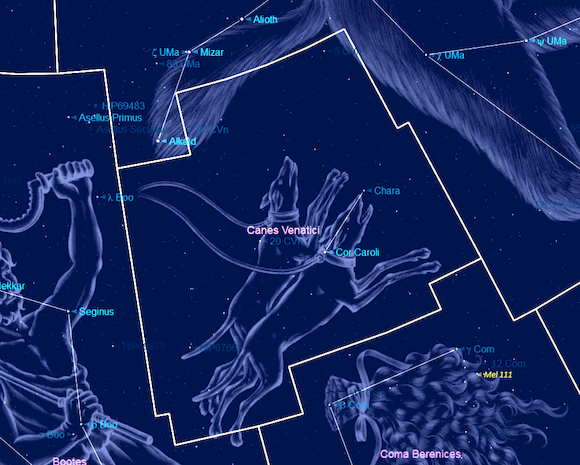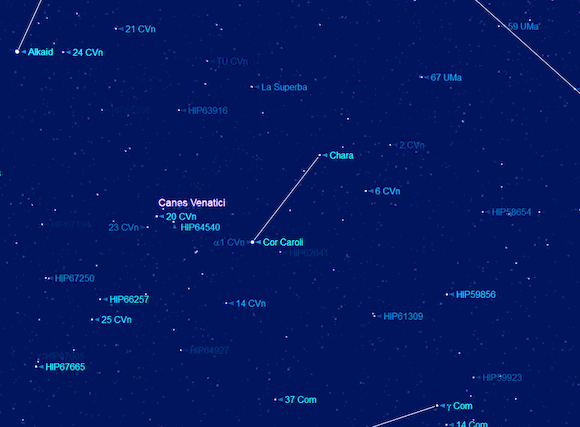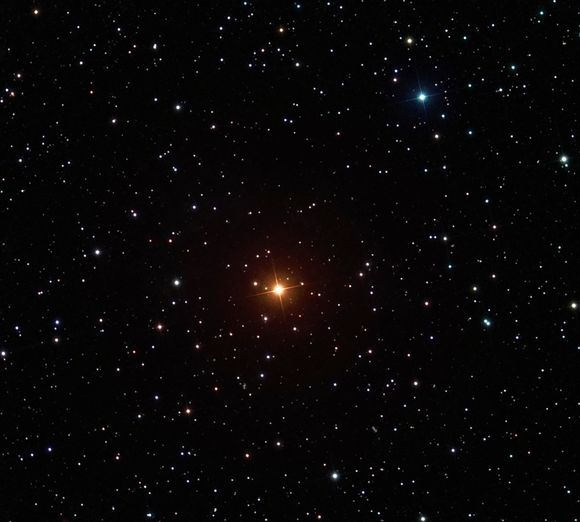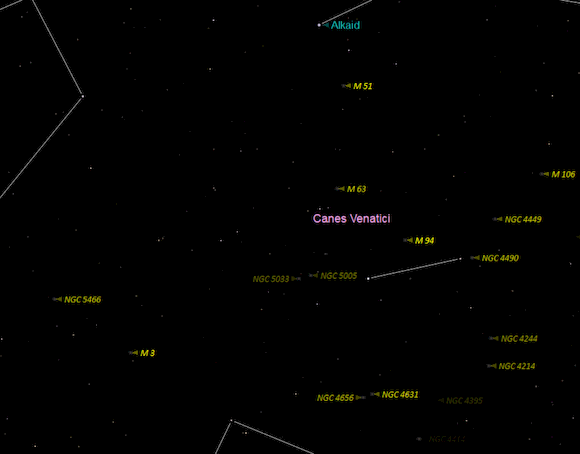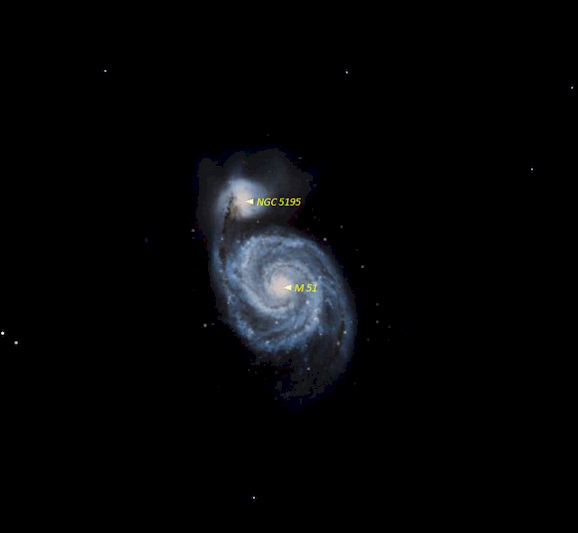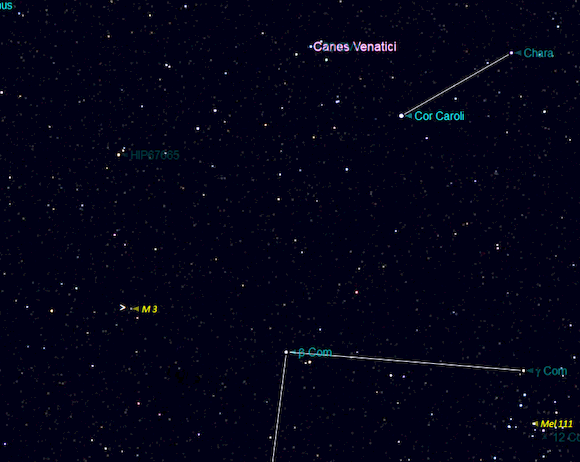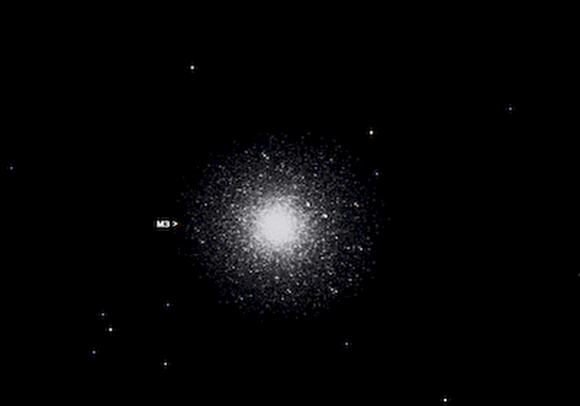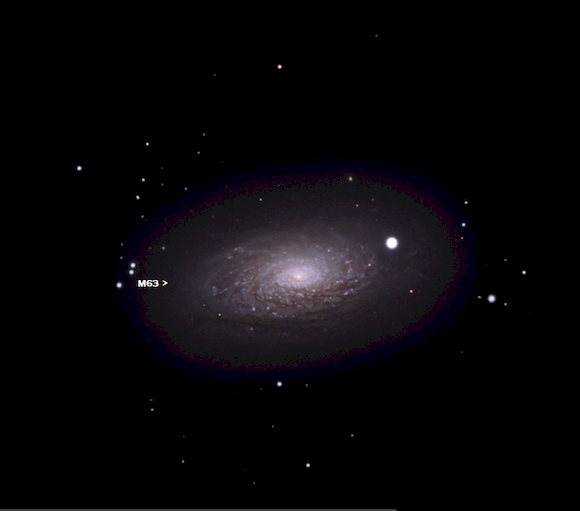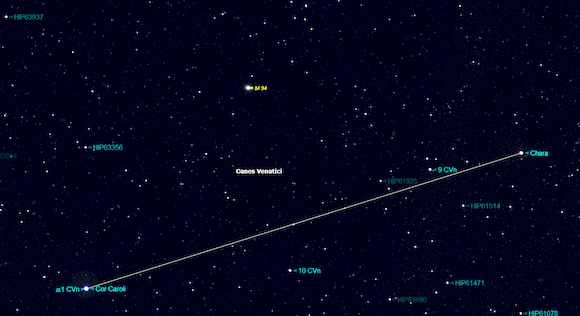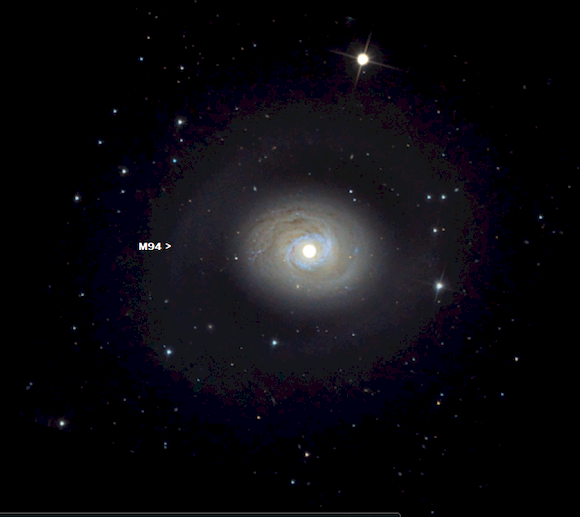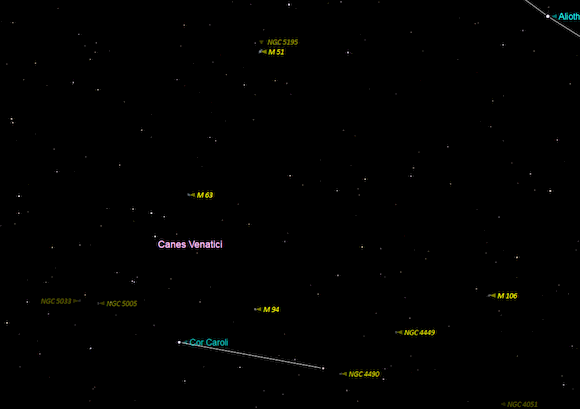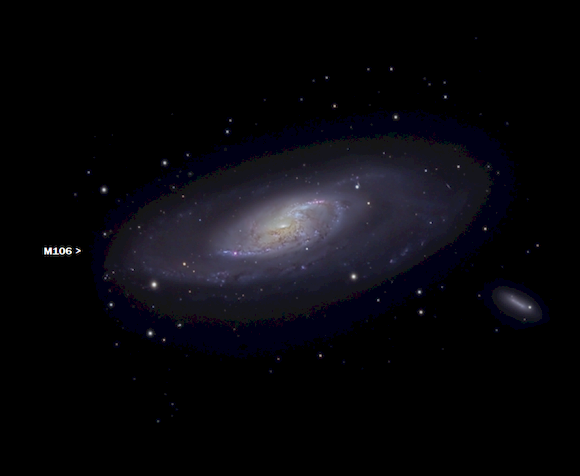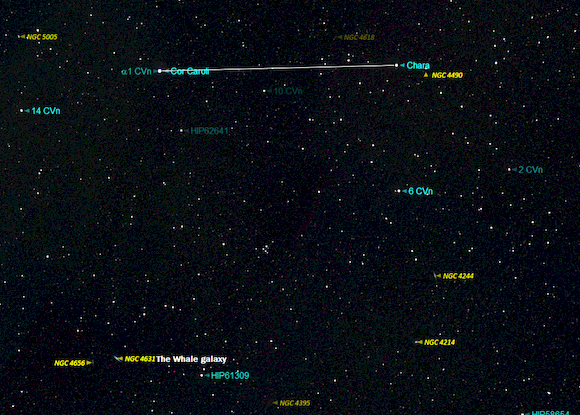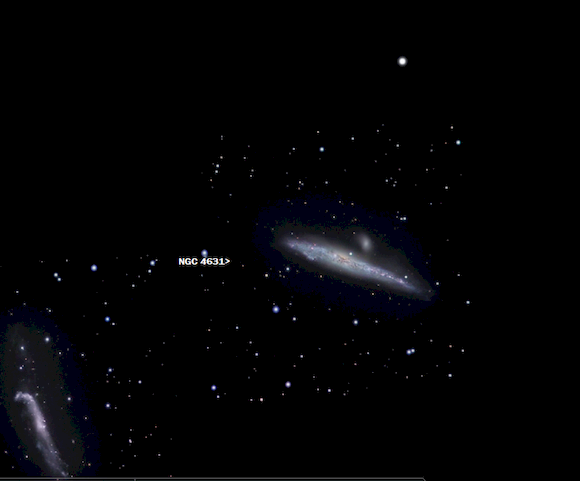Canes Venatici - The Hunting Dogs
This relatively ‘modern’ constellation formed by the Polish astronomer Johannes Hevelius in 1687 from a scattering of faint stars beneath the tail of Ursa Major is rather fortunate to have survived at all to become one of the 88 constellations recognised by the IAU. These ‘unformed’ stars had been noted and listed by Ptolemy in the Almagest centuries earlier below the figure of the Great Bear and so not belonging to any particular constellation, were free to be used in a new figure. It would appear however that the identification with the ‘dogs of Boötes’ arose through various mistranslations, initially from the Greek word for ‘Club’, which some of the stars in the upper reaches of Boötes the Herdsman traditionally represented, into the Arabic word for “staff having a hook” when translated into Arabic form Ptolemy’s Almagest. Later, when the Arabic text was then translated into Latin, the word “hook” was mistaken for “dogs” or to be more precise “spearshaft having dogs”. Thus the phantom dogs entered into astronomical writings until in 1687 Hevelius made them into the two hunting dogs. Perhaps though Hevelius should share the credit for the invention of Canes Ventatici with a Dutch cartographer; Willem Janszoon Blaeu. As far back as 1602 he had produced a globe in which Boötes holds two dogs following the Great Bear. The lead dog is marked by Alpha CVn and the follower by Beta Cvn and is probably the first attempt to utilise the main two stars in Venatici as separate dogs.
Hevelius named the dogs Asterion (alpha Cvn) and Chara (beta Cvn). Another popular name for Asterion is Cor Caroli, meaning Charles’s Heart, in honour of King Charles I of England. This name actually arose over a decade before Canes Venatici was formed by Hevelius, when Sir Charles Scarborough (1615–94), physician to King Charles I’s son, Charles II christened it thus, perhaps because it lies close to the Plough, which was popularly known in England as Charles’s Wain, or wagon then. When Hevelius introduced Canes Venatici in 1687 he incorporated this star into his new constellation. Canes Venatici is bordered by Ursa Major to the north and west, Coma Berenices to the south, and Boötes to the east. The constellation contains no bright stars, that said, Alpha and Beta, the two main stars are by no means difficult to identify some distance below the tail of Ursa Major, the Great Bear
- Alpha Venaticorum, Asterion or Cor Caroli ('heart of Charles'), is the constellation's brightest star and is one of the most attractive double stars for a small telescope, eventhough the colour contrast is slight. The primary has a magnitude of 2.89, the secondary star being magnitude 5.6. The primary is 110 light-years from Earth. It has an unusually intense variable magnetic field.
- Beta Canum Venaticorum, or Chara, is a yellow-hued main sequence star of magnitude 4.2. It lies 27 light-years from Earth.
- Y Canum Venaticorum -otherwise known as 'La Superba' in reference to the splendid appearance of its spectrum. It is a semi regular variable carbon star that varies between magnitudes 5.0 and 6.5 over a period of around 158 days. It is one of the reddest of naked eye stars, although for most observers sits at the edge of visibility. It may be located in a rather barren region of the constellation roughly a third of the way from Chara and Mizar in the handle of the Plough. Do have a peek at this red star in binoculars, the colour is oddly vivid.
- RS Canum Venaticorum is the prototype of a special class of binary stars of chromospherically active and optically variable components.
- R Canum Venaticorum is a Mira variable that ranges between magnitudes 6.5 and 12.9 over a period of approximately 329 days.
Deep Sky Objects
For a small constellation containing few naked eye stars, Canes Venatici has more than its fare share of deep sky objects, including 5 Messier objects and many NGC objects, one of which is in the Caldwell catalogue.
Perhaps the best known deep sky object in Canes Venatici is the Whirlpool Galaxy - M51, (NGC 5194) and its companion NGC 5195. This object was discovered by Charles Messier in October 1773, although the discovery of the second core is credited to Pierre Mechain in 1781. John Herschel saw a bright round nucleus surrounded by a nebulous ring, and thought of M51 as a distant Milky Way, perhaps the first to do so. It was however William Parsons, the 3rd Earl of Rosse in 1845 using the 'leviathan scope' of Birr Castle in Ireland, who distinguished the spiral nature of the nebula, the first galaxy recognised as having a spiral structure. It was not until Edwin Hubble in the early part of the 20th century, that such spiral nebulae were finally recognised as galaxies, totally separate to the Milky Way. M51 lies 27 million light-years from Earth and is considered to be one of the most beautiful face on galaxies visible. Together with NGC 5195 it is the finest example of a pair of interacting galaxies in the sky. The companion galaxy is currently around 500,000 light years behind the northern spiral arm of the primary. This has led to over 1000 star-forming regions and nebulae being formed in the spiral arms of M51. The smaller companion, NGC 5195, has very few star-forming regions, but does exhibit tidal tails, stars accelerated into highly elliptical orbits far from the galaxy. M51 is approximately 87,000 lights years in diameter; NGC 5195 is about half the size.
M3 (NGC 5272) is a beautiful globular cluster residing close to the southern border of Canes Venatici. It actually sits slightly closer to Arcturus, brightest star in Bootes than to Cor Caroli in Venatici. Project a line from one star to the other and you will find it just over half way. It was discovered by Messier in May 1764 and was actually his first true discovery. The cluster is rich, containing at least half a million stars appearing almost 18′ in diameter through the eyepiece. At magnitude 6.3 it is bright enough to be seen with binoculars and can even be seen with the naked eye under particularly dark skies. The cluster has a highly elliptical orbit which varies between 15,000 and 50,000 light years from the galactic centre. It currently lies just over 34,000 light years from Earth. M3 begins to resolve with an aperture of 4" and is superb in 8" scopes and above.
M63, NGC 5055, was the first discovery by Messier's colleague Pierre Mechain in early 1779 and was observed by Messier himself in June of that year. The 'Sunflower Galaxy', named for its appearance in large amateur telescopes is perhaps the most beautiful Messier galaxy, certainly on photographs. It is a large spiral galaxy almost 100,000 light years in diameter with fragmented or 'flocculent' multiple spiral arms. The galaxy resides around 27 million light years away and is a member of the M51 galaxy group. With an integrated magnitude of 9.0, M63 is visible in 10 x 50 binoculars, with the galaxy core apparent in small telescopes. Larger amateur scopes are required to perceive the spiral arms.
M94, (NGC 4736), is a face-on spiral galaxy 17 million light-years from Earth. It was discovered by Pierre Mechain, Messier's collaborator in 1781, who observed the object 2 days later after being informed by Mechain. It is a remarkable 'star burst' galaxy some 56,000 light years in diameter (half the Milky Way size). M94 has very tight spiral arms in which massive star formation is taking place. The core of the galaxy is bright and is populated by old red stars. The outskirts of the galaxy is incredibly luminous in the ultraviolet because of a ring of new stars surrounding the core 7,000 light-years in diameter. It is thought that the unusual 'star burst' structure of M94 is caused by a resonance of density waves with the galaxy's local rotational velocity. At magnitude +8.3, M94 is visible in 10 x 50 binoculars as a small well defined bright disk. The closed multiple ring structure only becomes more apparent with apertures of 5" above. The best way to locate M94 is to split the distance between Cor Caroli and Chara and extend up half that distance toward the Plough's handle.
M106 (NGC 4258) is a large spiral galaxy almost 26 million light years distant and some 135,000 light years in diameter, one of the largest in the catalogue. It was discovered by Pierre Mechain in 1783, who informed Messier by letter, although it is unclear whether Messier actually saw it himself. Images of M106 show a system orientation not dissimilar to M31- the Andromeda galaxy. Of all the galaxies in the Messier catalogue, M106, along with M51 are the easiest to see a visible spiral structure. The spiral arms contain prominent dust clouds that reach to the core, in which a massive black hole of 40 million solar masses lurks.
NGC 4631 is an edge-on barred spiral galaxy, which at magnitude +9.8 is one of the largest and brightest of its type in the sky. It is also known as the Whale galaxy due to its slightly distorted wedge shape. Neither Messier nor, Mechain came across this galaxy, which was discovered by William Herschel in 1787. It is number 32 in the Caldwell catalogue (Patrick Moore's list of objects that warrant attention or were missed by Messier et-al). NGC 4631 is positioned in south-western Canes Venatici, close to the border with Coma Berenices. The galaxy contains a central starburst region of intense star formation, spawning many hot, massive stars which only burn Hydrogen through fusion for a short period of time, after which they explode as supernovae. So many supernovae have exploded in the centre of NGC 4631 that they are blowing gas out of the plane of the galaxy which can be detected in X-rays and line emissions. At a distance of around 28 million light years, NGC 4631 spans 15.2 x 2.8 arc minutes of apparent sky and appears as a thin slither of light in 100mm (4-inch) telescopes. Through larger backyard scopes it is a splendid sight, large and bright, with some texture and mottling noticeable near the edges of its disk. Higher magnifications bring out even finer detail, including NGC 4627, a tiny oval shaped 13th magnitude satellite galaxy, seen just north of NGC 4631.
So, within the confines of this small, 'modern', 'mistranslation' of 'unformed stars', there is plenty of interest to keep the observer occupied at the eyepiece. Pick a moonless night to go barking mad!
Chart/picture credits:- Stellarium and Starry Night Pro plus 8, unless otherwise stated
- Log in to post comments

